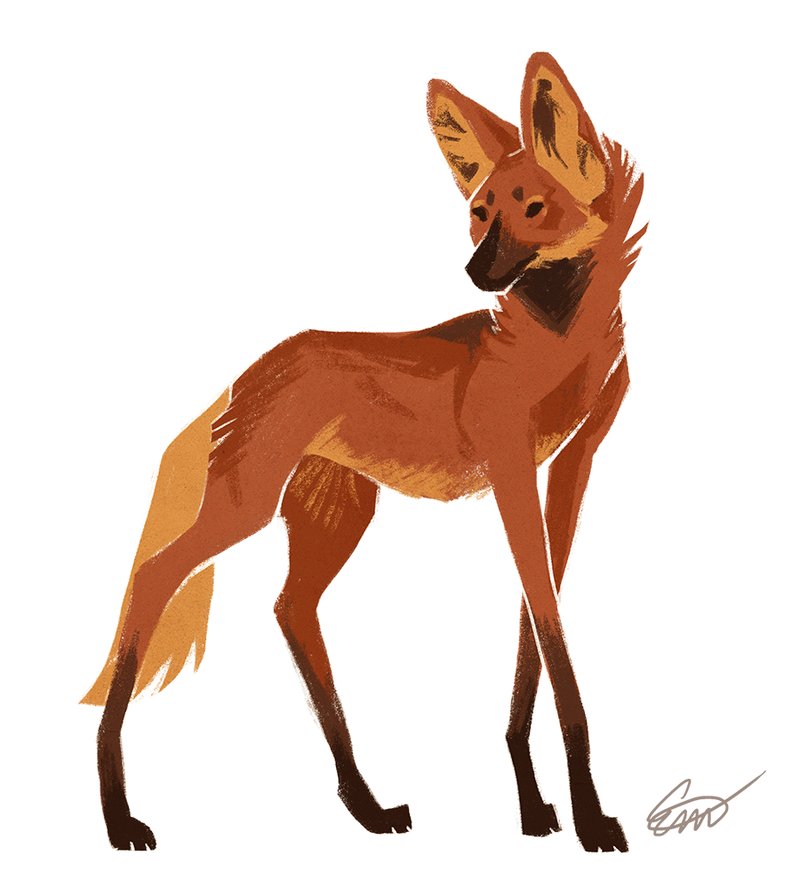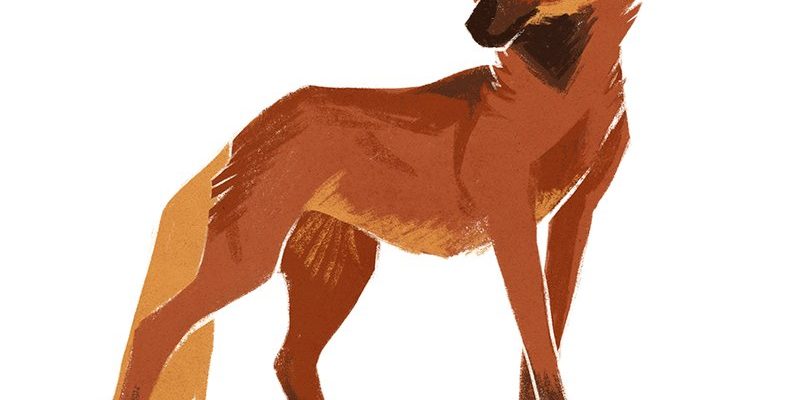
So, what makes the maned wolf stand out? And how can you easily tell it apart from its close relatives? Let’s dive into ten animals that could play the role of the maned wolf’s distant cousins. We’ll explore their unique traits and give you easy tips on how to differentiate them. You’d be surprised at how diverse the canine family really is!
1. Red Fox
The red fox is likely the most familiar face on our list. With its bright orange-red fur and bushy tail, it’s a beloved character in folklore. These cunning animals are adaptable and can thrive in various environments, from rural areas to city parks. Although they have shorter legs than the maned wolf, they share a similar sleek body shape.
When you’re trying to tell them apart, focus on their size and stature. The maned wolf stands taller and has long legs, while the red fox is more compact. Plus, the maned wolf has a distinctive mane of fur along its neck, which isn’t seen on the fox. Coloration can also be a giveaway—the red fox typically showcases vibrant red, while the maned wolf’s coat is more of a tawny brown.
2. Gray Wolf
Next up is the gray wolf, the classic wild canine. These guys are usually found in packs and are known for their intricate social structures. Like the maned wolf, gray wolves have that iconic wolfish appearance, but they’re built for strength rather than agility.
Now, here’s the kicker: while a gray wolf’s size can be impressive, the maned wolf appears leaner and taller, with its long legs giving it an elegant posture. Additionally, gray wolves have often a gray or brown coat, typically more uniform than the patchy coloration of the maned wolf. If you encounter one, remember that it’s usually more robust and muscular, while the maned wolf seems almost delicate in comparison.
3. African Wild Dog
The African wild dog is another fascinating relative of the maned wolf. These social hunters often travel in packs and rely on teamwork to catch their prey. Their large, rounded ears and spotted coat make them look quite different from the sleek maned wolf.
If you’re trying to tell these two apart, check out the body shape. African wild dogs are more playful and have a stockier build, with shorter legs and broader heads. Their coat also features distinct patches of yellow, black, and white, while the maned wolf’s fur is more uniform in color. Remember, the African wild dog is often a bit more flamboyant in its appearance!
4. Bush Dog
Next on the list, we have the less-known bush dog. These small canines are found in Central and South America and are adapted for a semi-aquatic lifestyle. They have a short coat, stocky build, and webbed toes for swimming.
In terms of size, the bush dog is much smaller than the maned wolf. While the maned wolf stands tall, bush dogs are compact and resemble more of a small terrier. Their coat is dark brown to black, unlike the maned wolf’s tawny hue. If you spot one, take note of its plump body and shorter legs—way more squat than the elegant maned wolf.
5. Dhole
The dhole, or Asiatic wild dog, is a fascinating creature hailing from Asia. They have a strong pack social structure, similar to gray wolves, but are smaller and generally more slender. Their fur is typically a reddish-brown, much like the maned wolf.
To distinguish a dhole, look for its bushy tail and the distinctive markings on its face. Dholes also have rounded ears, which contrast sharply with the maned wolf’s more pointed ears. Size-wise, the dhole is usually shorter and less lanky than the maned wolf, giving it a different overall silhouette.
6. Coyote
You might be most familiar with the coyote from cartoons or its howls in the wild. These adaptable creatures thrive across North America and have a slim, agile build. Although they can look similar to the maned wolf at a glance, they have some distinct features.
For one, coyotes have a more dog-like face with a shorter snout compared to the elongated features of the maned wolf. Their fur is typically a mix of brownish-gray, while the maned wolf’s coat is more golden and tan. Plus, coyotes tend to be smaller and stockier, which can help you tell them apart when you see them in the wild.
7. Fennec Fox
The fennec fox, with its adorable oversized ears and petite body, might seem worlds away from the maned wolf. However, both share a curiosity about their environments and a knack for survival in wild settings.
When comparing the two, you’ll notice that the fennec fox is much smaller and has a stocky body with short legs. Its fur is typically a sandy color, and those huge ears are designed to dissipate heat in the deserts of North Africa. The maned wolf, on the other hand, has a taller, more elegant frame with longer legs and different ear proportions.
8. Eurasian Lynx
While the Eurasian lynx isn’t a canine, it belongs to the same general family of wildlife and can confuse observers new to the animal kingdom. This wild cat has a sturdy build and is known for its tufted ears and distinctive spotted coat.
To differentiate them, look closely at the face. The lynx has a rounder face with a more pronounced beard-like ruff, while the maned wolf has a longer, more wolf-like face. Plus, lynxes are generally much shorter than the tall maned wolf, making them stand out in a unique way.
9. Jackal
Jackals are known for their scavenging skills and adaptability. They can often be spotted in Africa and parts of Asia. While they share some traits with the maned wolf, they differ significantly in size and appearance.
Jackals are shorter and have a more dog-like stature than the long-legged maned wolf. Their fur can be a mix of black, brown, and tan, but they lack the luxurious mane of fur that characterizes the maned wolf. In addition, jackals often have a more slender face with a shorter snout, making them easy to identify.
10. Kinkajou
This might come as a surprise, but the kinkajou—a rainforest-dwelling, nocturnal mammal—shares some habitat overlap with the maned wolf. Though not a canine, it’s a tree-dweller with a long tail and soft fur.
To spot the difference, focus on the body shape. Kinkajous are smaller, with rounded bodies and prehensile tails, while the maned wolf is a tall, leggy creature suited for terrestrial life. Kinkajous also have a much shorter snout, setting them apart from the elegant features of the maned wolf.
Exploring the animal kingdom can feel like stepping into a wild, colorful world teeming with fascinating creatures. The maned wolf stands out with its elegant stature and unique features, but it shares its habitat with various animals that can be easily confused for it. From the foxes and wolves to more exotic creatures like the kinkajou, each has its distinct charm.
Next time you’re out and about in nature—or just daydreaming over coffee—think about these diverse members of the animal family. By understanding their differences, you can appreciate their unique adaptations and roles in the ecosystem even more. So, which of these animals piqued your curiosity? Nature is full of surprises, and it’s always worth taking a closer look!

